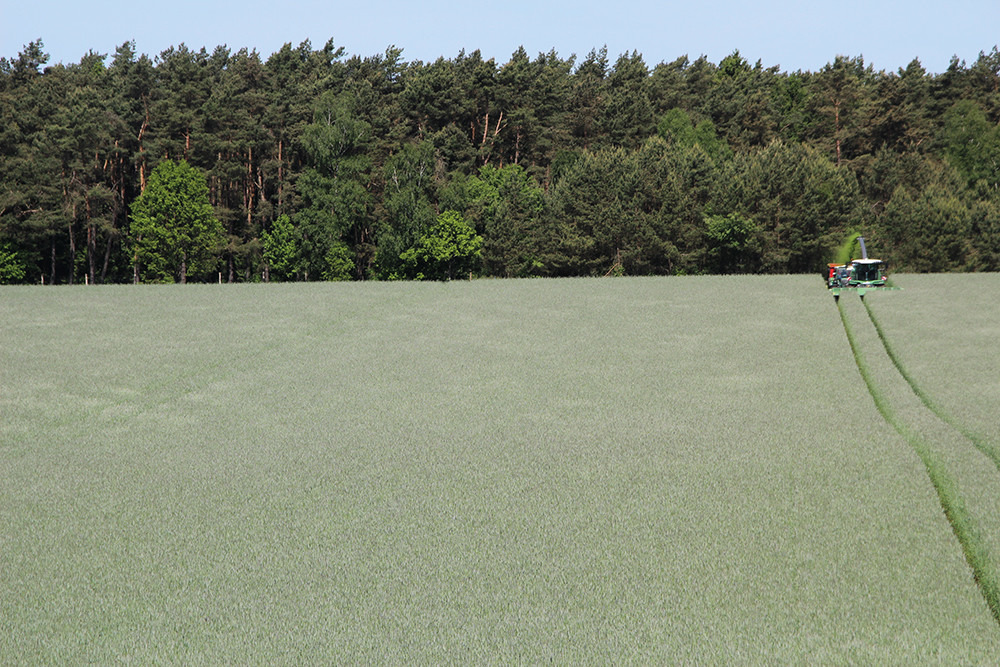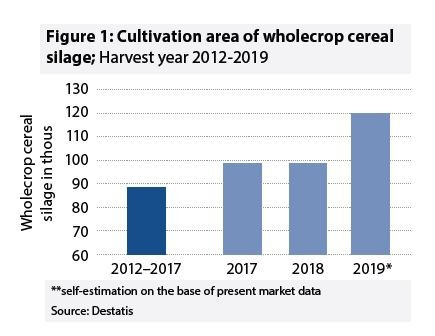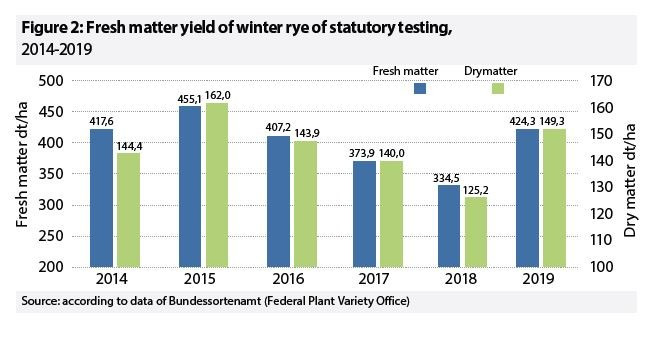Rye shows advantages in regard to climate change
In the year 2019 many farms have emphasised on diversity in order to fulfil agronomical challenges and public expectations. Therefore, the extremely versatile winter rye was able to regain considerable amounts of cultivation area. Fenja Luhmann, product manager hybrid rye explains that there are good reasons.

In the year 2018 rye cultivation area increased by 25 % to 637,000 ha. In comparison with the year 2018 there will be another moderate increase in the year 2019 as especially on marginal sites winter wheat and winter barley were replaced by rye. This has various reasons: On one hand the county variety trials over the last two dry years have shown again that hybrid rye is in terms of yield stability and potential, superior to other cereals. Furthermore, no other cereal offers such a wide range of use: As wholecrop silage for feeding or as plant biomass for biogas plants, rye grain for bread making or for feeding pigs and beef.
Cultivation area increases – with clear regional differences
Destatis (Federal Statistical Office of Germany) estimates that in Germany on a 6 year average (2012-2017) the wholecrop cereal silage cultivation area totals about 84.4 thous ha. The states with the largest wholecrop cereal cultivation area are Bavaria (approx. 33 thous), Baden-Wuerttemberg (approx. 14 thous) and Schleswig-Holstein (approx. 15 thous). Market observer reckon that 2019 the cultivation area of wholecrop cereal will increase to 120 thous (Figure 1).

The main counties in Germany to produce wholecrop rye silage are Schleswig-Holstein, Mecklenburg-Western Pomerania and Saxony-Anhalt harvesting about 35 thous hectare at harvest 2019. Compared to previous years it would be an increase of about 20 %. Statutory testing 2019 of wholecrop rye silage shows a dry matter yield of about 15 t/ha, which is above the long-term average (Figure 2).

Rye or triticale?
Often if the topic wholecrop cereal silage comes up winter rye and triticale are mentioned in one breath. Both have their advantages but several reasons favour rye. Especially in regions with pastoral farms winter triticale had been a constant but in the years 2018 and 2019 winter rye was superior to triticale in regard to yield potential and stability; not only on lighter soils but also on rich loamy soils.
Long-term trials carried out by the University of Applied Science Kiel in cooperation with SAATEN-UNION compare e.g. dry matter performance of winter crops like wheat, triticale, rye and barley on different sites: Rendsburg in Schleswig-Holstein and Moosburg in Bavaria. Both sites are loamy sands and belong with an average rainfall between 814 mm (Moosburg) and 850 (Rendsburg) to the regions with the highest precipitation in Germany. However, Moosburg has between 60 to 80 soil points (German soil classification) and Rendsburg only about 45. Trial results reflect how much they are influenced by site and yearly conditions (Figure 3).

Dry matter yield of winter rye (RW) and triticale (TW)
In the years 2015, 2018 and 2019 on both sites the weather conditions were subjected to an early summer drought. Even in Moosburg, a site where triticale has been dominating the yield performances for years, dry matter yield of rye was superior to triticale. Especially in the drought year 2018 rye showed an excellent drought tolerance.
Long-term trials carried out by the University of Applied Science Kiel in cooperation with SAATEN-UNION compare e.g. dry matter performance of winter crops like wheat, triticale, rye and barley on different sites: Rendsburg in Schleswig-Holstein and Moosburg in Bavaria. Both sites are loamy sands and belong with an average rainfall between 814 mm (Moosburg) and 850 (Rendsburg) to the regions with the highest precipitation in Germany. However, Moosburg has between 60 to 80 soil points (German soil classification) and Rendsburg only about 45. Trial results reflect how much they are influenced by site and yearly conditions (Figure 3).
It is also essential that the crop variety is healthy, especially if the importance of chemical pesticides is declining. While hybrid rye varieties have become healthier and got a better standing power, triticale has turned into an intensive crop. Due to an increasing occurrence of powdery mildew, yellow rust, brown rust and Fusarium high yielding triticale requires an increasingly higher amount of fungicides. Hybrid rye is the most efficient cereal crop by far. It achieves the highest yield when water and nutrient supply is limited. Due to a quick juvenile development and concurrent deep rooting rye has an about 10 % higher N uptake from organic fertiliser than triticale. Therefore, equivalent higher amounts of mineral fertiliser are taken up resulting in a clearly better nutrient balance. Additionally, even under adjusted fertilization rye can cope better with the difficult to calculate soil N mobilisation. Hybrid rye was bred for multipurpose usage ensuring high flexibility. Therefore, it is possible to decide short-term if the crop should be used as wholecrop silage or as grain rye.
Current climate scenarios predict for Central Europe an increase in early summer droughts. Evidentially, under those conditions drought resistant rye convinces as wholecrop silage as well as grain rye. Latter was also shown by the 8 year grain analysis of hybrid rye, triticale, barley and continuous wheat in the state variety trials carried out by KWS Lochow. On average rye achieved a 5 % higher yield compared to triticale and up to 20 % compared to continuous wheat.
Rye will suffer comparatively less than other cereals under the climate change and consequently will become increasingly important.
